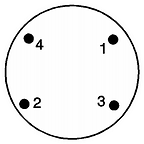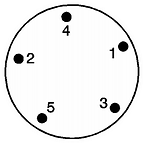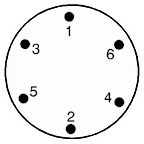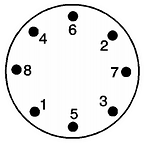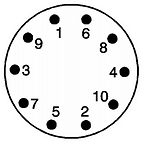Torquing Wheel Lug Nuts / Lug Bolts
Over the years, we've seen firsthand the ramifications of improperly torqued lug nut and lug bolts. We've seen wheels come off, brakes damaged, broken and/or stripped lug nuts, bolts and studs. And unfortunately, we have seen this time-and-again from professional technicians as well as the do-it-yourselfers - all for one simple reason - they failed to properly torque the lug nuts or bolts on their vehicles.
Lug studs and nuts as well as lug bolts are designed with a specific grade of hardware with a certain amount of "stretch." Stretch? You might ask - Yes. Proper torque, which stretches the bolt, causes the threads of the stud/bolt to tightly mate and secure to the matching nut or threaded hole (within the axle or wheel hub) without working themselves loose. It's akin to mechanically securing the nut to the bolt - except that you can remove and re-tighten it repeatedly, as needed., yet, most bolt grades used for this purpose will retain its original size and properties (un-stretched) when properly torqued to specifications. The properties of the bolt has a slight spring affect when loosened.
The below are examples of bolts in the various stages of torque:
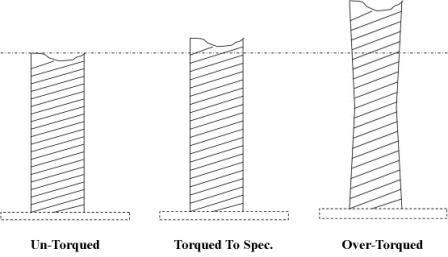
- The first example is a bolt that is loose, with no torque applied — unstretched.
- The second example is a bolt that is torqued to specification. There is a slight amount of stretch, but not enough to change metal/alloy properties of the bolt and it returns back to it's original shape and is ready for for retorquing.
- The third example is a typical of an over-torqued bolt. Note that the bolt has not only stretched, but stretched to the point of changing the properties and yield strength of the bolt. The bolt now has a much lower tensile/yield strength and allows the bolt to flex, generate heat and fatigue. A bolt that has been over-torqued will be prone to cracking, shearing, loosening, or breaking off which can result in damage to the wheel and other related components.
Improperly torqued lug nuts or bolts can also result in:
- Warped brake rotors — brakes grabbing, pulsating or overheated.
- Damage to the lug nut seating surface of alloy wheels.
- Wheel hub damage — threaded wholes stripped out.
It is also important to tighten lug nuts or bolts incrementally to the final torque specification, and doing so in the proper sequence.
The graphic below shows the three common bolt patterns and tightening sequences, appropriate for most automotive applications.
|
4 Lug Wheel Bolt |
5 Lug Wheel Bolt |
6 Lug Wheel Bolt |
8 Lug Wheel Bolt |
10 Lug Wheel Bolt |
|
|
|
|
|
|
It is prudent to recheck the torque specifications after a test drive of the vehicle, especially with alloy or painted wheels. It is very possible to falsely torque lug nuts or bolts due to excess paint, debris, corrosion or a tight and binding centering hole over the wheel hub that allows the bolt or nut to come loose after the vibrations and rigors of driving.
When installing new wheels you should re-torque the wheel lugs after driving the first 50 to 100 miles in case the clamping loads have changed following the initial installation. This is necessary due to the possibility of metal compression/elongation or thermal stresses affecting the wheels as they are breaking in, as well as to verify the accuracy of the original installation. When rechecking torque value, wait for the wheels to cool to ambient temperature (never torque a hot wheel). Loosen and retighten to value, in sequence. Simply repeat the same torque procedure listed above.
General Torque Specifications
| Hardware Bolt or Stud Size |
Typical Torque Range in Ft/Lbs |
Minimum Number of Turns of Hardware Engagement |
| 12 x 1.5 mm | 70 - 80 | 6.5 |
| 12 x 1.25 mm | 70 - 80 | 8 |
| 14 x 1.5 mm | 85 - 90 | 7.5 |
| 14 x 1.25 mm | 85 - 90 | 9 |
| 7/16 in. | 70 - 80 | 8 |
| 1/2 in. | 75 - 85 | 8 |
| 9/16 in. | 135 - 145 | 8 |
Wheel lug torque specifications are for clean threads that are free of dirt, grit, etc. If applying an anti-seize lubricant, it is important to note it can be applied only on the threads of nuts or bolts. The lubricant must not be used on either seat of the hardware of the wheel. With the seat being the main point of friction where torque is measured, extreme caution must be used if an anti-seize lubricant is applied to the threads as excess can either drip or be pushed onto the lug seat resulting in inaccurate torque values.
A thread chaser or tap should be used to remove any burrs or obstructions of the threads allowing the lug hardware to be turned by hand until it meets the wheel's lug seat. Once lugs are snugged down, finish tightening them with an accurate torque wrench. Use the appropriate crisscross sequence (shown above) for the number of wheel lugs on your vehicle until all have reached their proper torque value. Be careful because if you over-torque a wheel, you can strip a lug nut or hub, stretch or break a stud or bolt, and cause the wheel, brake rotor and/or brake drum to distort.
